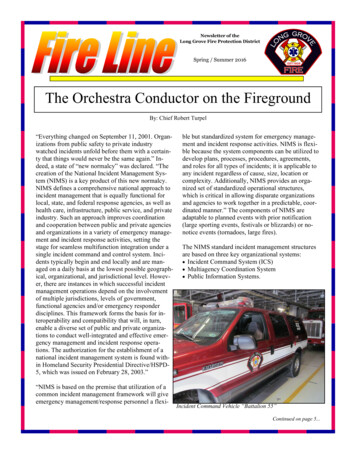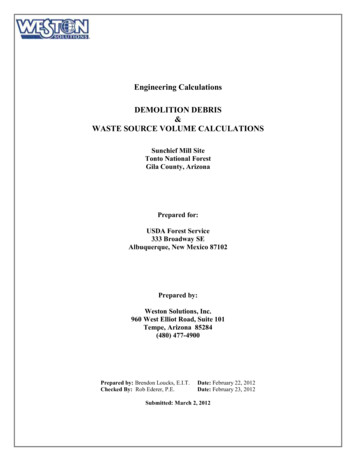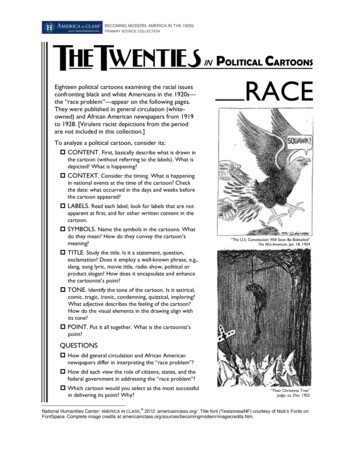
Transcription
Demolition Means Progress:Race, Class, and the Deconstruction of the American Dream in Flint, Michigan(Volume 1)byAndrew R. HighsmithA dissertation submitted in partial fulfillmentof the requirements for the degree ofDoctor of Philosophy(History)in the University of Michigan2009Doctoral Committee:Associate Professor Matthew D. Lassiter, Co-ChairProfessor J. Mills Thornton III, Co-ChairProfessor Francis X. Blouin Jr.Associate Professor Matthew J. CountrymanAssistant Professor Joseph Donald Grengs
Andrew R. Highsmith2009
For Bobby and Asha May,who sparkle and shineii
AcknowledgementsI could not have written this dissertation without the guidance and support of manyteachers, colleagues, friends, and family members, so it is my special privilege to thankthem here. The circuitous journey leading to this project began when I was a teenagergrowing up in Cincinnati, Ohio, long before I knew anything about Flint, Michigan.There, a civil rights pioneer named Fred Shuttlesworth got me thinking about race andpolitics for the first time, and his stories of struggle forever changed my life. At theCollege of William and Mary, Melvin Ely showed me how to become a better listener, amore diligent researcher, and a more incisive writer. In Chicago, I learned some of life‘smost valuable lessons from the students, faculty, and staff of DuSable High School.They deserve a special mention for reminding me about the importance of schools. As agraduate student at DePaul University, I had the privilege of working with Larry Bennettand Howard Lindsey, who nurtured my interests in race, class, and urban politics.Equally important, they helped me get into graduate school at the University ofMichigan, which should not have happened.The University of Michigan is a fantastic place to study, teach, and write history.Since arriving here, I have been especially fortunate to work with Kathleen Canning, ParCassel, Robert Fishman, Kevin Gaines, Sue Juster, Scott Kurashige, Earl Lewis, MicheleMitchell, Maria Montoya, Anthony Mora, Regina Morantz-Sanchez, William Rosenberg,Julius Scott, Penny Von Eschen, and many other esteemed historians. As talented asthese scholars and teachers are, the Department of History simply could not functioniii
without the grace and expertise of Lorna Alstetter, Sheila Coley, Diana Denney, KathyEvaldson, Dawn Kapalla, Kathleen King, and other staff members. Thank you all forhelping me navigate my way through graduate school.Like many dissertations, this project is deeply rooted in archival research. Noneof it would have been possible without help from the librarians, archivists, and staffmembers at the Flint Public Library; the Frances Willson Thompson Library and theGenesee Historical Collections Center at the University of Michigan-Flint; the Flint CityClerk‘s Office; the Perry Archives of the Alfred P. Sloan Museum; the Richard P.Scharchburg Archives at Kettering University; the Bentley Historical Library and theHarlan Hatcher Graduate Library at the University of Michigan; the National Archivesand Records Administration facilities in Chicago and College Park, Maryland; theLibrary of Michigan; the Flint Journal Archive; and the Walter P. Reuther Library ofLabor and Urban Affairs at Wayne State University. I owe special debts to Paul Gifford,the archivist at the University of Michigan-Flint, Dave Larzelere from the Flint JournalArchive, and Jeff Taylor from the Perry Archives, who have been extraordinarily helpfuland supportive over the years. During my long sojourn in the archives, I spent manymonths getting to know Olive Beasley, Aileen Butler, Paul Cabell, Woody Etherly, JohnHightower, Edgar Holt, and other Flint activists who tried to build a more equitableregion. They deserve a special acknowledgement for providing me with information andinspiration. Thanks also to Ananthakrishnan Aiyer, Dave Doherty, Ernest Holman, JasonKosnoski, Albert Price, Dayne Walling, David White, and members of the BlackTeacher‘s Caucus, who love Flint in spite of its faults and taught me a great deal aboutthe texture of life in the Vehicle City.iv
This project received generous financial support from a number of differentinstitutions. Grants and fellowships from the Nonprofit and Public Management Center,the Eisenberg Institute for Historical Studies, and the Institute for the Humanities, all atthe University of Michigan, the Spencer Foundation, the Andrew W. Mellon Foundation,and the American Council of Learned Societies allowed me to complete this dissertationwithout falling into debt.Just as important, benefactors from these organizationsprovided me with several opportunities to meet and collaborate with a talented pool ofscholars from across the disciplinary spectrum. I feel especially grateful to have workedwith (and befriended) Uwem Akpan, Eric Avila, Bob Beckley, Tomiko Brown-Nagin,Andy Clarno, Claire Decoteau, Philip Duker, Ansley Erickson, Phil Ethington, DavidFreund, Brett Gadsden, Scott Gelber, David Goldfield, Kim Greenwell, Patricia Haggler,Edin Hajdarpasic, Christie Hanzlik-Green, Joseph Heathcott, Daniel Herwitz, JenniferHochschild, Irene Holliman, Christina Kelly, Ed Kelly, German Kim, Kevin Kruse,Kristina Luce, Marti Lybeck, Sarah Manekin, Howard Markel, Khaled Mattawa, NataliaMehlman-Petrzela, Christi Merrill, Guian McKee, Pamela Newkirk, Becky Nicolaides,Rachel O‘Toole, Diana Bullen Presciutti, James Robson, Mark Rose, Andrew Shryock,Jamie Tappenden, Patricia Yaeger, and Norman Yoffee. Their questions and suggestionshave greatly improved the quality of my work.I am overjoyed to acknowledge the five wonderful individuals who served on mydissertation committee. Fran Blouin read many drafts of this dissertation and providedvaluable feedback at every stage of the writing and revision process.MatthewCountryman challenged me to think about the politics of civil rights in new ways, posedprobing questions about race and region, and wrote several letters on my behalf. Josephv
Grengs encouraged me to devote more attention to urban planners and pushed me to thinkconcretely about connections between past and present. Mills Thornton, one of thesmartest people I have ever known, has been a close advisor since the day I arrived inAnn Arbor. Even as my intellectual interests vacillated, Mills stuck with me, alwaysasking tough questions, pointing out errors in argumentation and syntax, and providing amodel of professionalism. More than anything else, though, Mills taught me that localpolitics really matter. I could not have asked for a better advisor than Matthew Lassiter.For over seven years now, Matt has supported me in ways that I cannot even begin toacknowledge here. He has read and dissected virtually every word that I have writtensince I moved to Michigan, including conference papers, fellowship proposals, journalarticles, and multiple drafts of this dissertation—and he did it all with the patience of asaint and the care of a surgeon. Matt also helped me to reorganize the dissertation into itscurrent form and challenged me to think through and re-think all of the conceptualframeworks employed in this project. Beyond that, he has provided an amazing modelfor the sort of scholar, teacher, advisor, and citizen that I aspire to become one day. Matt,I owe you my deepest and sincerest thanks for everything that you have done for me.You are truly one of a kind.I am extremely fortunate to have an amazing group of smart and sympatheticfriends. For listening to my stories about Flint, keeping me grounded, and showing mewhat really matters in life, sincere thanks to Tamar Carroll, Aaron Cavin, SherriCharleston, Ania Cichopek, Dan Cieslik, Nathan Connolly, Tyler Cornelius, AllenDieterich-Ward, Josh First, Sara First, Lily Geismer, Todd Getz, Brendan Goff, BradGoldberg, Clay Howard, Betty Hull, Matt Ides, Jeff Kaja, Robert Kruckeberg, Millingtonvi
Lockwood, Will Mackintosh, Rob Maclean, Cynthia Marasigan, Pascal Massinon, DrewMeyers, Josh Mound, Tim Minich, Andrew Needham, Lisa Nelson, Tim Nelson, JasonOtto, Jennifer Palmer, Alyssa Picard, Anthony Ross, David Schlitt, Pete Soppelsa,Herbert Sosa, Lakshmi Swaminathan, Raj Swaminathan, Stephanie Taber, StephenWisniewski, Matt Wittmann, and Mike Zilliox. Thanks also to my friends and colleaguesat the American History Workshop and the Metropolitan History Workshop, whoprovided great intellectual stimulation and a camaraderie that I will always cherish.Members of my family have been a constant source of strength throughout mylife. Without them, my world would be incomplete. For your love and laughs and foraccepting me into your beautiful family, thanks to Arjun, Esha, Neha, and MeenaChadha, Baldev Singh, Geeta Singh, and Hardev ―Wuncle‖ Singh. Now that this projectis finished, we should all meet in Delhi for chai, samosas, and the spiciest street food wecan find. Many thanks as well to Comilla Sasson and A. J. Hegg, who are both familymembers and friends. This acknowledgement would not be complete without a specialthank you to Satwant Sasson, my second mother, for her love, spunk, and constantsupport. Yes, Mom, I am now officially finished with graduate school. My grandfather,Ferris Highsmith, will also be happy to know that my formal education is complete.Thanks for supporting me for all of these years, Boppa.My other grandparents—Gerald Fearer, Rogene Fearer, and Pauline Highsmith—passed away before this project began, but my memories of them continue to bring mejoy and inspiration.So too do thoughts of Suvinder Chadha, William Fearer, andJagmohan Singh, who did not live to see this day. To Ruby and Leon Highsmith, two ofmy favorite companions, I miss you very much and think of you often.vii
Although I moved away from Cincinnati many years ago, a piece of my heart willalways remain there with my family. Many thanks to David Highsmith and AllegraNicodemus, who are building a wonderful new life together. I owe a special hello andthank you to their two little turkeys—Evan and Maya Highsmith—who I adore with all ofthe love that my heart can hold. My parents, Robert and Martha Highsmith, deservemore gratitude than I can possibly communicate here. For over three decades now, theyhave offered me their unconditional love and support.Mom and Dad, you havedemonstrated by your own examples what it means to be a doting parent, a loving spouse,and a decent human being. For all of that and more, you have my sincerest thanks anddeepest love.Finally, I would like to acknowledge Bobby Sasson and Asha May Highsmith, thetwo most amazing people I have ever known. When we met ten years ago, Bobby, Iknew right away that you were special (that‘s why I kept calling you). Little did I know,however, that we were going to spend the rest of our lives together. For reading all of mywork and making it better, staying by my side when this dissertation (and my life)seemed to spiral out of control, and being my biggest fan, I thank you from the bottom ofmy heart. Today, more than ever, thoughts of spending my life with you make mehappier than you will ever know. My heart is yours, Bobby, now and forever. Andfinally, the newest love of my life: Asha May Highsmith. Ashy, you made your debutright in the middle of this project. Now, you are the smartest, prettiest, funniest, andmost incredible little two-year-old girl in the whole world. I cannot imagine my lifewithout you in it, my sweet love, because you have made my world complete. Thank youfor your hugs and kisses, our trips to the park and story time, singing songs and cuddling,viii
and for everything else that we do together . . . together. Being your daddy (and yourmommy‘s husband) makes me the luckiest person in the world. That is why I dedicatethis dissertation to you both, the two loves of my life.ix
ContentsDedicationiiAcknowledgementsiiiList of FiguresxiiList of MapsxiiiList of TablesxivIntroductionPart 11Race and Space in a Company TownChapter 1The Ghetto and the Master Builder38Chapter 2Making Better Citizens and a Stronger Community:The Birth of Community Education and Neighborhood Schools90Chapter 3Formalizing the Pigment Partition:Public Policies and Racial Segregation in Postwar Flint133Chapter 4Jim Crow, GM Crow:Black Workers and the Limits of Postwar Abundance174Chapter 5Suburban Strategies:Building Flint‘s Industrial Garden202Chapter 6Chaos in the Suburbs:The Life and Death of New Flint269x
Part 2Civil Rights, Suburban Revolts, and the Roots of the Rust BeltChapter 7―Our City Believes in Lily-White Neighborhoods‖:The Campaign for Open Housing317Chapter 8Confronting a Geographic Fiction:The Battle for School Desegregation362Chapter 9Demolition Means Progress:Urban Renewal, Freeways, and State-Sanctioned Ghetto Formation403Chapter 10White Flight and Beyond:Residential Jim Crow in the Era of Open Housing482Chapter 11Cities with Walls:Race, Class, and the Death of Metropolitan Solutions529Chapter 12―The Fall of Flint‖:Decline and Renewal in the Post-Vehicle City591ConclusionAmerica Is a Thousand Flints628Bibliography650xi
List of FiguresI.1. GM‘s 50 millionth car, a Flint-made Chevrolet Bel Aire sports coupe, 195421.1. ―Homes of the Homeless,‖ ca. 1920471.2. Modern homes in a modern city, 2004602.1. ―These Were Happy Days,‖ ca. 19541082.2. Mott adult education leaflet, ca. 19501243.1. Leaflet promoting Flint‘s primary units, n.d.1623.2. Primary unit, 20061647.1. Open housing demonstration, 19673559.1. St. John Street, 19714239.2. ―Demolition Means Progress,‖ 200547812.1. Opening day parade at AutoWorld, July 198461512.2. An elevated ―skyway‖ at the University of Michigan-Flint, 2005619C.1. Buick City, 2005648xii
List of Maps3.1. Flint Public Schools map, ca. 19551596.1. Map of New Flint boundaries, 19583039.1. Flint‘s North End, 1966419xiii
List of Tables3.1. Racial segregation in Flint elementary schools, 1950-19601554.1. Downtown employment figures, 19591874.2. General Motors employment figures, 19651995.1. Residential dwellings constructed in the Flint metropolitan area, 1930-195223912.1. Average General Motors employment in Genesee County, 1946-1985596xiv
IntroductionThe city of Flint salutes you,to General Motors, we raise our voice in song.The city of Flint salutes you,to General Motors, the hand of friendship strong.The city of Flint salutes you,for the goal you‘ve reached today.We are proud to be your neighbor,and we‘re glad that you came to stay.—Song honoring the fiftieth anniversary of the incorporation of General Motors, 19581We Northerners tend to look down on the South from a moral valley; not a mountain top. In many ways theNorth is no better off than the South; its system of ghettoization and segregation is just as deplorable asDixie‘s, and just as harsh and inhumane.—Whitney M. Young, Jr., Executive Director, National Urban League, ca. 19652On November 23, 1954, a celebration erupted in the industrial city of Flint, Michigan. Atprecisely 10:10 on that crisp fall morning, workers cheered, factory whistles screeched,and ―aerial bombs‖ exploded in the sky as a sparkling sports coupe rolled off the finalassembly line at a General Motors Corporation (GM) plant just south of the city. Thegold-plated, gold-trimmed Chevrolet Bel Aire was GM‘s 50 millionth car produced in theUnited States, and hundreds of journalists, automobile executives, and civic leadersgathered at the company‘s Van Slyke Road assembly plant to bear witness to history. Asworkers put the final touches on the coupe, plant supervisors shut down the assembly lineand summoned all present to hear speeches by GM President Harlow Curtice and1A 1958 film commemorating the fiftieth anniversary of GM‘s founding features this song. See AmongOur Souvenirs (General Motors Corporation, 1958).2This undated remark is quoted in ―A Flint Paradox,‖ Circle (May 1965), Urban League of Flint Papers,box 1, folder 8, Genesee Historical Collections Center, University of Michigan-Flint, Flint, Michigan(hereinafter cited as GHCC).1
Chevrolet General Manager T. H. Keating. In an address broadcast by closed-circuittelevision to GM plants across the country, Curtice identified the golden vehicle as asymbol of industrial accomplishment unmatched in world history. ―That car is the 50millionth car produced by General Motors in the United States since 1908,‖ Curticeproclaimed. ―Fifty million cars are more cars than any other country or any combinationof other countries has ever produced. They represent a production feat that surpassesanything ever achieved by any other industrial organization.‖3 Like many of the revelerswho had amassed to observe this historic event, Curtice viewed November 23 as a day tocelebrate GM‘s corporate progress, the triumphs of American capitalism and democracy,and the seemingly boundless consumer prosperity generated by the post-World War IIeconomic boom. The Vehicle City of Flint and its nearly 200,000 residents were readyfor a party.Figure I.1. GM‘s 50 millionth car, a Flint-made Chevrolet Bel Aire sports coupe, 1954.Courtesy of llionth-car.html.3―50 Millionth GM Auto Touches Off Big Celebration,‖ Flint Journal, November 23, 1954; ―CurticePraises Employees of GM,‖ Flint Journal, November 23, 1954.2
Flint was a fitting place to celebrate GM‘s ―Golden Carnival,‖ the largest andmost keenly anticipated bash in the city‘s hundred-year municipal history. In 1908, Flintindustrialist William Crapo Durant founded General Motors. By 1954, metropolitanFlint—with nearly eighty thousand local workers on the corporation‘s payroll—washome to the greatest concentration of GM factories and employees anywhere in theworld. During the weeks leading up to November 23, Curtice, Flint Mayor GeorgeAlgoe, Flint Journal newspaper editor Michael Gorman, and other civic leaders hadmeticulously planned the festivities. In order to minimize traffic gridlock, corporateofficials paid for free citywide bus service throughout the day. For his part, BuickGeneral Manager Ivan Wiles sponsored complimentary babysitting services, whichallowed thousands of new parents to participate fully in the event. To mark the occasion,nearly 150,000 people flocked to downtown Flint for a parade, music, dancing, andspeeches.Following his address at the Van Slyke Road plant in suburban FlintTownship, Curtice and other special guests boarded cars and buses bound for SaginawStreet in the heart of Flint‘s central business district. Joining Curtice and other honoredguests for the parade were three hundred top GM executives, many of whom had arrivedearlier in the day from Detroit courtesy of a privately chartered golden train. Once theyarrived downtown, observers received commemorative golden feathers distributed byrepresentatives from the Flint Chamber of Commerce. With feathers tucked in theirfedoras, pillboxes, and ball caps, parade watchers enjoyed ―a spectacle of magnificentcolor and beauty,‖ complete with fireworks, bands, and eight thousand golden balloonsfloating overhead.44―Symbolic Auto Touches Off Big Celebration Here,‖ Flint Journal, November 23, 1954.3
The Golden Carnival commenced within minutes of the Bel Aire‘s completion.Upon reaching downtown, Curtice and his guests made their way to a parade reviewstand in front of the luxurious Durant Hotel. A ―three-bomb salute‖ greeted the Curticecaravan as it approached the hotel, followed shortly thereafter by ten additional ―bombblasts‖ that opened the parade. The highlight of the Golden Carnival, of course, was thenew Bel Aire sports coupe, which sat atop the final float. Still, the hour-long eventfeatured a variety of entertaining performances and spectacles designed to captivate justabout anyone. Among the main attractions were nine marching bands from local highschools and colleges; five shiny white convertibles that previewed GM‘s 1955 line ofautomobiles; a display sponsored by the United Automobile Workers (UAW), Flint‘slargest labor union; a special float dedicated to ―Mr. and Mrs. USA,‖ which carried ayoung white family representing GM‘s loyal consumers; and performances by the ―highstepping Dreyer sisters, national baton twirling champions.‖5 Heralded by journalists forits scrupulous planning and military-like precision, the Golden Carnival was one of themost carefully orchestrated, lavish celebrations of mass production and consumption inAmerican civic history. Indeed, one of the day‘s only unscripted moments occurredwhen an errant metal baton tossed by a Michigan State College twirler struck an overheadpower line, raining red-hot sparks over a section of the parade route.6 When asked by aFlint Journal reporter to comment on the event, L. A. Clark, a Flint resident for morethan eighty years, stated, ―I‘ve seen everything that‘s happened in Flint but nothing halfas big as this. It was 500 per cent better than anything I‘ve seen before.‖75―Spectacle Is Climaxed by 50 Millionth Car,‖ Flint Journal, November 23, 1954.Flint Journal, November 23, 1954.7―Brilliant Parade Tells General Motors Story,‖ Flint Journal, November 23, 1954; ―Windows, Trees andRoofs Crowded along Carnival‘s Line of March, Flint Journal, November 23, 1954.64
The corporate and municipal officials who planned the Golden Carnival hopedthat it would demonstrate the solidarity that connected Flint and General Motors,autoworkers and their employers, and loyal consumers with their trusted GM products.In order to strengthen those bonds, GM factory managers hosted open houses in all oftheir plants nationwide on November 23, providing citizens with unprecedented access tothe company‘s industrial facilities. Following the parade in Flint, over 100,000 peopledispersed to visit the nine GM complexes scattered throughout Genesee County. Becausethe Flint Board of Education cancelled school for the day, thousands of childrenaccompanied their parents to the factories. Once inside the plants, children witnessedfirsthand the marvels of modern automobile production, learned about the workenvironments of loved ones, and, perhaps, even caught a glimpse of their own futureworkplaces. Curtice and other corporate and civic dignitaries continued their celebrationat the Industrial Mutual Association (IMA) auditorium just northeast of downtown, whereGM hosted a Golden Carnival luncheon for three thousand invited guests. At the IMAgathering, Curtice announced a 3 million gift from GM to fund the city‘s new culturalcenter. According to Curtice, a longtime Flint resident, GM‘s gift to the city was anexpression of the corporation‘s desire to be a ―good citizen of our plant communities andto assume the duties and responsibilities that good citizenship imposes.‖8 Mayor Algoebragged that Flint was the ―envy of all other industrial cities in the United States.‖ In theopinion of F. A. Bower, Buick‘s retired chief engineer, ―The GM carnival was thegreatest day in the history of Flint.‖ ―With Mr. Curtice at the head,‖ Bower predicted,―both the corporation and the city of Flint are assured of great prosperity.‖9 To Bower89―Curtice Announces 3,000,000 Flint Cultural Center Grant,‖ Flint Journal, November 23, 1954.―Consensus in Flint: Golden Carnival Great,‖ Flint Journal, November 25, 1954.5
and Algoe, the Golden Carnival seemed to mark the permanent triumph of industrialprogress, consumer prosperity, and social opportunity in the Vehicle City. With itsextraordinarily high wages, low unemployment, internationally renowned public schools,and high rates of home ownership, Flint was truly a remarkable sight on that goldenNovember day.The Golden Carnival was a festival of both truth and fiction. Although thesplendor of the day made it difficult to detect, the 1954 extravaganza concealed just asmuch as it revealed about the texture of daily life in Flint, the relationship between thecity and General Motors, and the corporation‘s commitment to prosperity and opportunityin its hometown. In their stories about the tribute, reporters from the Flint Journalsaluted Flint‘s civic progress and the corporate triumphs of General Motors. On thatsame day, however, the newspaper‘s classified section featured Jim Crow advertisementsfrom local citizens seeking white nannies, ―Colored‖ tenants, and white homebuyers.Furthermore, when Harlow Curtice and his colleagues made their trek from the nearly allwhite suburb of Flint Township to the Golden Carnival parade in downtown Flint, theytraveled along Saginaw Street, the Vehicle City‘s most persistent racial fault line. As thefloat carrying the golden Bel Aire rolled north towards downtown, it passed by severalall-white neighborhoods just west of Saginaw that carefully excluded African Americans.On the east side of the street, by contrast, sat Floral Park, one of only two areas in citywhere black citizens could obtain housing in 1954. Once they arrived downtown, Curticeand other GM executives viewed the parade from the grounds of the Durant Hotel, awhites-only establishment. After the parade, Curtice attended a whites-only luncheon atthe IMA auditorium, where he announced GM‘s 3 million gift to the city. The donation6
funded a cultural center adjacent to the all-white Woodlawn Park district, a neighborhoodthat black people could visit, but only during the daytime. Beneath the glare of theGolden Carnival, Flint was among the most segregated cities in the United States; and themunicipal officials and corporate executives who presided over the day‘s amusementswere largely to blame for those conditions.Flint was also a city teetering on the brink of disaster.During the decadepreceding the Golden Carnival, tens of thousands of white taxpayers moved away fromthe city in search of newer and better housing in the racially segregated suburbs ofGenesee County. Their departures caused major tax and service gaps in the increasinglyblack metropolis. Over the same period, GM and other local employers implemented asuburban investment strategy in Genesee County that redirected jobs, taxes, and capitalfrom the city to the suburbs. The state-of-the-art Chevrolet assembly plant that birthedGM‘s 50 millionth vehicle was located not in Flint but in suburban Flint Township, fivemiles southwest of the city‘s downtown business district. Though few contemporariesnoted the irony in GM‘s decision to feature a suburban plant in its celebration of Flint‘splace in industrial history, the significance of the company‘s capital decentralizationcampaign cannot be overstated.Ultimately, the suburban migrations of whitehomeowners and businesses severely undermined the vitality of Flint‘s booming postwareconomy.Tragically, F. A. Bower‘s predictions of stability and prosperity for the VehicleCity turned out to be false. By 1974, only two decades after the Golden Carnival, thepopular mood in Flint had shifted markedly. During the oil shortages and inflationarycrisis of the 1970s, American automakers saw their sales decline precipitously. With its7
lineup consisting almost entirely of large, heavy, energy inefficient cars and trucks, GMsuffered devastating losses during the oil shocks of 1973-74 and 1979. In January 1974,with over thirty thousand Flint residents out of work, the Vehicle City‘s unemploymentrate stood at 15.1 percent, the highest in the nation.10 Although GM had regained asubstantial portion of its market share by 1978, the sales slumps and economic downturnsof the 1970s and early 1980s marked the end of the postwar boom and the onset of a newera of mass deindustrialization in Genesee County. During the 1980s, Flint autoworkerssuffered through a seemingly unending series of layoffs and plant closures that cut GM‘semployment in the region in half. Between 1955 and 1987, the company eliminatedthirty-four thousand jobs in the Flint area.11The lean years had only just begun, though. The high-tech and Wall Street boomsof the 1990s did little to stem the loss of jobs from the Vehicle City. During the 1990s,10Flint Journal, October 8, 1974. See also, Bryan D. Jones and Lynn W. Bachelor, The Sustaining Hand:Community Leadership and Corporate Power (Lawrence: University Press of Kansas, 1986); RonaldEdsforth, Class Conflict and Cultural Consensus: The Making of a Mass Consumer Society in Flint,Michigan (New Brunswick: Rutgers University Press, 1987), esp. 191-228; James D. Ananich, Neil O.Leighton, and Charles T. Webber, Economic Impact of Plant Closings in Flint, Michigan (Flint: Regents ofthe University of Michigan, 1989); Steven P. Dandaneau, A Town Abandoned: Flint, Michigan, ConfrontsDeindustrialization (Albany: State University of New York Press, 1996); and Theodore J. Gilman, NoMiracles Here: Fighting Urban Decline in Japan and the United States (Albany: State University of NewYork Press, 2001).11On organized labor and the economic retrenchment of the 1970s and 1980s, see William Serrin, TheCompany and the Union: The ―Civilized Relationship‖ of the General Motors Corporation and the UnitedAutomobile Workers (New York: Random House, 1973); Dudley W. Buffa, Union Power and AmericanDemocracy: The UAW and the Democratic Party, 1935-1972 (Ann Arbor: University of Michigan Press,1984); Robert Reich and John Donahue, New Deals: The Chrysler Revival and the American System (NewYork: Times Books, 1985); Harry Katz, Shifting Gears: Changing Labor Relations in the U.S. AutomobileIndustry (Cambridge: Massachusetts Institute of Technology Press, 1985); Mike Davis, Prisoners of theAmerican Dream: Politics and Economy in the History of the US Working Class (London: Verso, 1986);Kim Moody, An Injury to All: The Decline of American Unionism (London: Verso, 1988), 95-126; BarbaraEhrenreich, Fear of Falling: The Inner Life of the Middle Class (New York: Pantheon, 1989); RobertZieger, American Workers, American Unions, 1920-1985 (Baltimore: Johns Hopkins University Press,1995), 201-211; Nelson Lichtenstein, The Most Dangerous Man in Detroit: Walter Reuther and the Fate ofAmerican Labor (New York: Basic Books, 1995), 439-44
There, a civil rights pioneer named Fred Shuttlesworth got me thinking about race and politics for the first time, and his stories of struggle forever changed my life. At the College of William and Mary, Melvin Ely showed me how to become a better listener, a more diligent researcher, and a more incisive writer.










